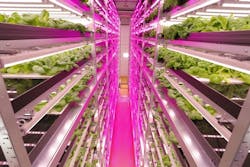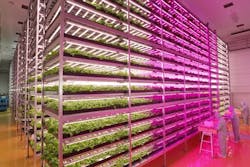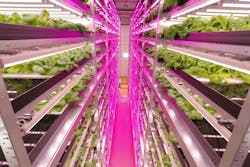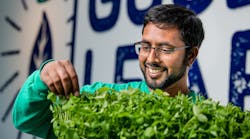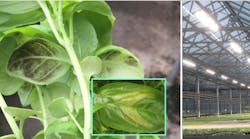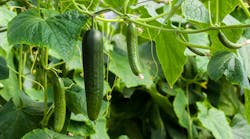A Japanese indoor farm produces 10,000 heads of lettuce per day under LED lighting while university researchers study the impacts on SSL in bedding plant and tomato applications.
LED-based lighting has found success in farming and horticultural applications in part because of energy efficiency, but more significantly based on improved productivity. GE Lighting has enabled an urban lettuce farm that can produce 10,000 heads daily. Researchers at McGill University in Canada, meanwhile, have documented that LED lighting can boost tomato production, and Purdue University researchers similarly documented productivity improvements in bedding plants.
We've covered the basics in LED lighting for horticulture previously. The narrow spectrum of LEDs in different colors can be selected to enhance the photosynthesis process while also offering energy savings relative to broad-spectrum HID or fluorescent lights used in commercial farming. Moreover, Philips Lighting recently announced a partnership with commercial grower Green Sense Farms intended to both minimize energy usage for indoor growing towers and enable food to be produced closer to consumers.
Tagajo lettuce farm
The documented benefits of LEDs in horticulture continue to build with the recent announcement of the Mirai lettuce farm in the city of Tagajo that's located in the Miyagi Prefecture (jurisdiction) in Japan. GE Lighting, specifically GE Japan Corp, developed customized LED lighting for the farm that is located in a facility that previously hosted a Sony electronics manufacturing center located in the Miyagi Fukko Park.
Development of the farm was subsidized by the Japanese Ministry of Economy, Trade and Industry (METI) and is part of the reconstruction effort as the region recovers from the impact of the Great East Japan Earthquake that occurred in 2011.
The project leveraged the electronic-centric features of the building such as cleanroom facilities and thermal insulation to provide an ideal climate and air circulation for the farming application. Mirai worked with GE, meanwhile, to develop LED lighting tuned to the lettuce growing cycle. METI also encouraged the use of technology in the farm that uses customized sensors and control systems for all aspects of the agricultural environment. The partners say that the result is 50% better plant production relative to fluorescent-lit farms along with a 40% reduction in energy usage.
The farm occupies 2300m2 of floor space and there are 17,500 LED lights in use. As the nearby photo depicts, the lettuce is grown in cultivation racks to maximize the use of the high ceilings. The result is the aforementioned 10,000-head daily harvest. Meanwhile, the success of the project has the partners looking to develop other LED-lit farms in Japan and to inquiries from interested parties in other regions of the globe.
Tomatoes and bedding plants
In other horticultural news, there are two recent university projects that have been published on the academic website HortScience. In both cases, university researchers studied mixes of red- and blue-LED lighting relative to high-pressure sodium (HPS) lighting in horticultural applications.
The Purdue University project was focused on bedding plants including flowers. Specifially, the team studied the growth of Antirrhinum, Catharanthus, Celosia, Impatiens, Pelargonium, Petunia, Tagetes, Salvia, andViola seedlings. A quantitative measure called the Quality Index (QI) showed much better results for Petunia, Salvia, and Viola plants under the LED lighting, and the results relative to HPS were considered similar for the other varietals.
The McGill University researchers, from Ste-Anne-de-Bellevue, Quebec, studied tomato production under HPS light, HPS light mixed with LED light, and LED light. All of the mixes of LED light tested proved superior in tomato production to HPS light alone. But the best results were obtained by a 50:50 mix of the narrow-spectrum red and blue LED lighting combined with HPS lighting.
